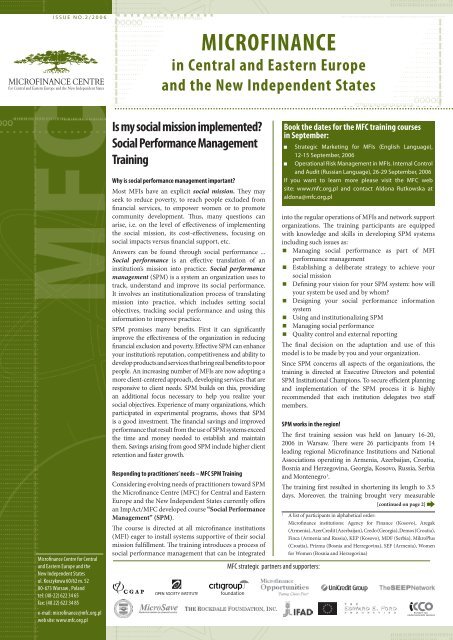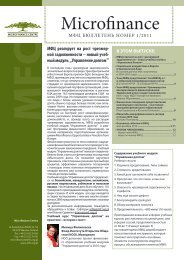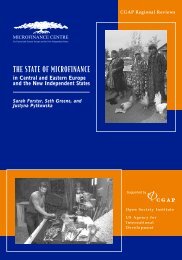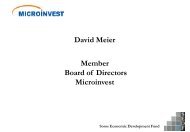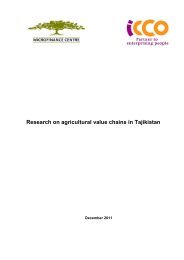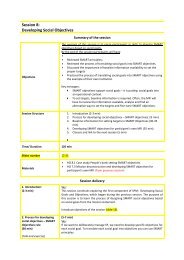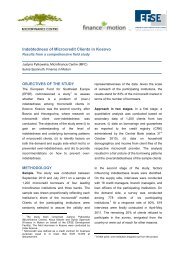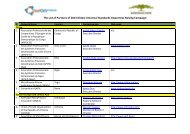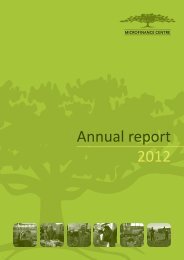MFC Newsletter 2- 2006.pdf - Microfinance Centre
MFC Newsletter 2- 2006.pdf - Microfinance Centre
MFC Newsletter 2- 2006.pdf - Microfinance Centre
Create successful ePaper yourself
Turn your PDF publications into a flip-book with our unique Google optimized e-Paper software.
I S S U E N O . 2 / 2 0 0 6<br />
<strong>Microfinance</strong> <strong>Centre</strong> for Central<br />
and Eastern Europe and the<br />
New Independent States<br />
ul. Koszykowa 60/62 m. 52<br />
00-673 Warsaw , Poland<br />
tel: (48-22) 622 34 65<br />
fax: (48 22) 622 34 85<br />
e-mail: microfinance@mfc.org.pl<br />
web site: www.mfc.org.pl<br />
MICROFINANCE<br />
in Central and Eastern Europe<br />
and the New Independent States<br />
............................................................................................................................<br />
Is my social mission implemented?<br />
Social Performance Management<br />
Training<br />
Why is social performance management important?<br />
Most MFIs have an explicit social mission. They may<br />
seek to reduce poverty, to reach people excluded from<br />
financial services, to empower women or to promote<br />
community development. Thus, many questions can<br />
arise, i.e. on the level of effectiveness of implementing<br />
the social mission, its cost-effectiveness, focusing on<br />
social impacts versus financial support, etc.<br />
Answers can be found through social performance ...<br />
Social performance is an effective translation of an<br />
institution’s mission into practice. Social performance<br />
management (SPM) is a system an organization uses to<br />
track, understand and improve its social performance.<br />
It involves an institutionalization process of translating<br />
mission into practice, which includes setting social<br />
objectives, tracking social performance and using this<br />
information to improve practice.<br />
SPM promises many benefits. First it can significantly<br />
improve the effectiveness of the organization in reducing<br />
financial exclusion and poverty. Effective SPM can enhance<br />
your institution’s reputation, competitiveness and ability to<br />
develop products and services that bring real benefits to poor<br />
people. An increasing number of MFIs are now adopting a<br />
more client-centered approach, developing services that are<br />
responsive to client needs. SPM builds on this, providing<br />
an additional focus necessary to help you realize your<br />
social objectives. Experience of many organizations, which<br />
participated in experimental programs, shows that SPM<br />
is a good investment. The financial savings and improved<br />
performance that result from the use of SPM systems exceed<br />
the time and money needed to establish and maintain<br />
them. Savings arising from good SPM include higher client<br />
retention and faster growth.<br />
Responding to practitioners’ needs – <strong>MFC</strong> SPM Training<br />
Considering evolving needs of practitioners toward SPM<br />
the <strong>Microfinance</strong> <strong>Centre</strong> (<strong>MFC</strong>) for Central and Eastern<br />
Europe and the New Independent States currently offers<br />
an ImpAct/<strong>MFC</strong> developed course “Social Performance<br />
Management” (SPM).<br />
The course is directed at all microfinance institutions<br />
(MFI) eager to install systems supportive of their social<br />
mission fulfillment. The training introduces a process of<br />
social performance management that can be integrated<br />
<strong>MFC</strong> strategic partners and supporters:<br />
Book the dates for the <strong>MFC</strong> training courses<br />
in September:<br />
Strategic Marketing for MFIs (English Language),<br />
12-15 September, 2006<br />
Operational Risk Management in MFIs. Internal Control<br />
and Audit (Russian Language), 26-29 September, 2006<br />
If you want to learn more please visit the <strong>MFC</strong> web<br />
site: www.mfc.org.pl and contact Aldona Rutkowska at<br />
aldona@mfc.org.pl<br />
into the regular operations of MFIs and network support<br />
organizations. The training participants are equipped<br />
with knowledge and skills in developing SPM systems<br />
including such issues as:<br />
• Managing social performance as part of MFI<br />
performance management<br />
• Establishing a deliberate strategy to achieve your<br />
social mission<br />
• Defining your vision for your SPM system: how will<br />
your system be used and by whom?<br />
• Designing your social performance information<br />
system<br />
Using and institutionalizing SPM<br />
Managing social performance<br />
• Quality control and external reporting<br />
The final decision on the adaptation and use of this<br />
model is to be made by you and your organization.<br />
Since SPM concerns all aspects of the organizations, the<br />
training is directed at Executive Directors and potential<br />
SPM Institutional Champions. To secure efficient planning<br />
and implementation of the SPM process it is highly<br />
recommended that each institution delegates two staff<br />
members.<br />
SPM works in the region!<br />
The first training session was held on January 16-20,<br />
2006 in Warsaw. There were 26 participants from 14<br />
leading regional <strong>Microfinance</strong> Institutions and National<br />
Associations operating in Armenia, Azerbaijan, Croatia,<br />
Bosnia and Herzegovina, Georgia, Kosovo, Russia, Serbia<br />
and Montenegro 1 .<br />
The training first resulted in shortening its length to 3.5<br />
days. Moreover, the training brought very measurable<br />
[continued on page 2]<br />
1<br />
A list of participants in alphabetical order:<br />
<strong>Microfinance</strong> institutions: Agency for Finance (Kosovo), Aregak<br />
(Armenia), AzerCredit (Azerbaijan), Credo (Georgia), Demos (Croatia),<br />
Finca (Armenia and Russia), KEP (Kosovo), MDF (Serbia), MikroPlus<br />
(Croatia), Prizma (Bosnia and Herzegovina), SEF (Armenia), Women<br />
for Women (Bosnia and Herzegovina)
MICROFINANCE IN C&EE AND THE NIS<br />
[continued from page 1]<br />
outputs for all the participants who currently are finalizing the concepts<br />
of SPM for their institutions. It was noticed that establishing directions<br />
for an MFI and aligning all the systems with this will probably result<br />
in higher cost-effectiveness as there is no need to do everything at the<br />
time. In addition, training participants realized that implementation of<br />
SPM is doable even for the small institutions as there is a possibility to<br />
build on what you already have in the institution.<br />
Furthermore, the training participants promote the SPM concept<br />
locally. The concept was presented by the Association of <strong>Microfinance</strong><br />
Institution of Kosovo (AMIK) to its member MFIs while Azerbaijan<br />
Micro-Finance Association (AMFA) made an SPM presentation at<br />
its membership meeting in March. At the FINCA Eurasia Meeting in<br />
April, FINCA participants of the Warsaw SPM training made a joint<br />
presentation to other country directors on what they learned at the<br />
workshop. The meeting gathered programs from seven different<br />
countries in the region<br />
The training served as a basis for initiating the work of the Regional<br />
Social Performance Working Group to advance social performance<br />
management in the region. The members are planning to share their<br />
conclusions from the process of the finalization of SPM concepts at<br />
Financial Education<br />
for Low-Income Households:<br />
Linking Needs to Products<br />
by Michal Matul 1<br />
In transition settings of Eastern Europe and Central Asia (EE&CA),<br />
financial literacy levels of low-income households are low. This<br />
reflects the ingrained practices of communist times, when people<br />
were discouraged from managing their finances. Most low-income<br />
households still do not prepare long-term financial plans and rarely<br />
save in a regular way. In addition, the majority of the low-income<br />
population is still unbanked. Confronted with crises and lacking<br />
in financial reserves, these people are forced to borrow extensively<br />
from MFIs, other financial providers as well as family and friends to<br />
respond to life and emergency risks.<br />
The findings below suggest why the inclusion of low-income households<br />
in the market economy remains difficult. For the more than 250 million<br />
low-income households in EE&CA, responses to crises are reactive.<br />
Borrowing, a first course of action, results in high rates of indebtedness<br />
and thus can make for a bumpy road out of poverty.<br />
1<br />
Michal Matul is researcher at <strong>MFC</strong> (michal@mfc.org.pl).<br />
<strong>MFC</strong> HIGHLIGHTS<br />
First delivery of the “Essentials of <strong>Microfinance</strong> in Financial<br />
Services in Rural Areas” training course<br />
The training was developed by <strong>MFC</strong> in English and Russian. It was offered in<br />
March in Almaty. 27 participants from 21 regional MFIs attended.<br />
Financial Education Conference in Warsaw, Poland<br />
On January 31 <strong>MFC</strong> organized a successful conference in Warsaw, where<br />
the package “Plan Your Future” was presented and the future of financial<br />
education for low-income people in Poland was discussed. The conference<br />
brought together more than 80 participants. A strategic goal to extend basic<br />
financial education to 5 million Polish households by 2010 was set.<br />
<strong>MFC</strong> took a strategic decision to make financial education one of its key<br />
activities. Big gaps exist in financial education among low-income people in<br />
transition countries, hampering the construction of inclusive financial sectors<br />
in Eastern Europe and Central Asia. <strong>MFC</strong> would like to act as a facilitator to<br />
disseminate new tools and practices to other transition countries.<br />
www.mfc.org.pl<br />
the upcoming meeting of SPM Working Group scheduled on June<br />
6 in Budapest, Hungary. Due to their enthusiasm and commitment<br />
the Working Group promises a variety of experiences to be shared<br />
that will be further disseminated within the industry.<br />
Want to learn more?<br />
<strong>MFC</strong> is currently looking for like-minded partners (national networks<br />
and MFIs) that want to assume leadership in their countries to spread<br />
the idea of social performance management. Those who are willing<br />
to learn more are cordially invited to the workshops on SPM that will<br />
organized during the coming <strong>MFC</strong>-EMN conference (May 8-9 in<br />
Budapest, Hungary). The workshop titled “Networks’ Role in Promoting<br />
Social Performance” is aimed at MFI national networks while the other,<br />
“Applying Social Lens,” is geared toward practitioners.<br />
If you want to learn more, please contact Katarzyna Pawlak (kasia@mfc.org.pl)<br />
or Dorota Szubert (dorota@mfc.org.pl)<br />
2<br />
National networks: Azerbaijan Micro-Finance Association (AMFA), The Association of<br />
<strong>Microfinance</strong> Institutions of Kosovo (AMIK)<br />
In response to substantial needs, <strong>MFC</strong> plans to promote the financial<br />
education agenda in EE&CA (see more at www.mfc.org.pl/finedu).<br />
This focus is in line with <strong>MFC</strong>’s mission to facilitate the development<br />
of socially oriented and sustainable microfinance. <strong>MFC</strong> plans to<br />
raise the financial literacy levels of low-income households by:<br />
• raising awareness of local stakeholders through organizing<br />
workshops in EE&CA countries<br />
• adapting and developing tools to enhance financial<br />
education in a unique transition context<br />
• facilitating the development of diverse and cost-effective<br />
models to deliver financial education services<br />
• training local stakeholders in delivering financial education<br />
• supporting creation of local organizations specialized in<br />
enhancing financial education<br />
Financial education is about teaching the knowledge, skills and<br />
attitudes required to adopt good money management practices for<br />
earning, spending, saving, borrowing and investing. It combines<br />
economic education with the promotion of entrepreneurial attitudes.<br />
Financial education creates an awareness of the benefits of financial<br />
planning and builds the capacity of the low-income households to<br />
gain control of their financial resources and better manage their scarce<br />
[continued on page 3]<br />
Poverty Assessment Tools Practicality Test - The USAID research<br />
sponsored project<br />
The second visits to partner institutions KLF (Kazakhstan) and Prizma<br />
(Bosnia and Herzegovina) were carried out in April and May 2006 by <strong>MFC</strong><br />
consultants, while the first visits took place in February and March. The visits<br />
aimed at documentation of the process from the point of view of practicality.<br />
The Krakow III Policy Forum on Law and Regulation Governing<br />
<strong>Microfinance</strong><br />
It was a unique event gathering high-level policy makers that took place in<br />
Warsaw, Poland, on April 6-8, 2006. The event was organized by <strong>MFC</strong> in<br />
partnership with USAID, CGAP and ICCO.<br />
The Forum brought together 34 carefully selected policy makers and topranking<br />
public officials from 9 NIS countries - Armenia, Azerbaijan,<br />
Georgia, Kazakhstan, Kyrgyzstan, Moldova, Russia, Tajikistan, and<br />
Uzbekistan as well as a small number of donor representatives and experts<br />
involved in microfinance and financial sector policy work. The event<br />
gathered 17 speakers and commentators from 8 countries. The Forum
www.mfc.org.pl<br />
[continued from page 2]<br />
capital. In this way financial education enables people to combine<br />
information and resources to enhance their economic security and<br />
more effectively use financial services.<br />
The social and economic benefits of financial education are gaining<br />
recognition within the microfinance sector. Earlier this year, <strong>Microfinance</strong><br />
Opportunities and Freedom from Hunger released the first-ever financial<br />
education package targeted at microfinance clients and other low-income<br />
households. The package is the result of a three-year action-research<br />
project which was undertaken with six partners worldwide. Funded by<br />
Citigroup Foundation, the package includes an implementation guide,<br />
and ToT and trainers manuals for five generic modules on budgeting,<br />
saving, debt-management, banking services, and financial negotiations.<br />
Within this global project <strong>MFC</strong> has developed a financial education<br />
curriculum for transition contexts – “Plan Your Future.” Developed<br />
and pilot tested in Poland, the “Plan Your Future” package contains<br />
materials for trainers to run financial education workshops. A central<br />
objective of the curriculum is to change people’s negative attitudes<br />
ISSUE NO.2/2006<br />
toward long-term financial planning and saving as well as broaden<br />
savings options. To date, the response to “Plan for the Future” has<br />
been very positive and it is currently being implemented on a large<br />
scale by a Consortium of diverse institutions (from non-governmental<br />
and banking sectors). The Consortium (www.edufin.org.pl), under<br />
the direction of <strong>MFC</strong>, seeks to increase financial literacy of 5 million<br />
low-income households in Poland by 2015.<br />
Financial education in EE&CA is timely. There is an increasing<br />
recognition that encouraging low-income people to become proactive<br />
is vital if these households are to emerge and stay out of poverty.<br />
Furthermore, by exposing people to new knowledge, skills and<br />
attitudes about effective management of financial resources, financial<br />
education increases the likelihood that low-income populations will<br />
adopt new and existing financial products and services. The gains for<br />
microfinance institutions are considerable. Better informed clients<br />
make for better consumers of financial services, which in turn improve<br />
bottom lines of financial institutions.<br />
Saving, borrowing and using bank accounts in selected countries of Eastern Europe<br />
<br />
<br />
<br />
<br />
<br />
<br />
<br />
<br />
<br />
<br />
<br />
<br />
<br />
<br />
<br />
<br />
<br />
<br />
<br />
<br />
<br />
<br />
<br />
<br />
<br />
<br />
<br />
<br />
<br />
<br />
<br />
<br />
<br />
<br />
Source: Representative national surveys (n=1000) conducted by <strong>MFC</strong> for Microinsurance <strong>Centre</strong> and KfW. Lower income households are those living below 200% of the<br />
national poverty line in each country. Households saving regularly are those who declare the fact of regular savings. Regarding debt the question is about repaying<br />
any (formal or informal) loan. Bank accounts refer to all types of bank accounts (current, term, etc.).<br />
included plenary presentations, seminars as well as receptions to welcome<br />
the partcipants and facilitate networking. The discussions during the<br />
Krakow III Policy Forum were organized around the following four issues<br />
of significant importance to the development of the microfinance sector in<br />
the region and globally:<br />
• policy reform measures that have the potential to increase<br />
significantly the provision of financial services to lower-income<br />
populations and to microenterprises - the issue contained two topics:<br />
branchless banking and credit bureaus<br />
•<br />
measures that might inadvertently constrain access to financial<br />
services for these clients, including measures aimed at combating<br />
money laundering and the financing of terrorism and interest rate<br />
caps<br />
•<br />
financial cooperatives – the potential risks of over-regulation and of<br />
under-regulation, and strategies to strike a sensible balance between<br />
them<br />
•<br />
issues to consider regarding government-sponsored guaranteed<br />
funds established to support microfinance<br />
Round Table with Tajik Government Officials<br />
After an introductory meeting last year, the Ministry of Labor and Social<br />
Protection of Tajikistan approached the Central Asia <strong>Microfinance</strong> Center<br />
(CAC) office in January with a request to advise them on microfinance<br />
best practices and the best practices of the government’s involvement in<br />
microfinance<br />
In response, a four-hour round table discussion for Tajik government<br />
officials was scheduled to address the following objectives:<br />
discourage the government from participating in direct lending;<br />
•<br />
make the government understand that microcredit may not be suitable for<br />
all categories of the poor (i.e. that the unemployed may not be able to<br />
repay);<br />
•<br />
educate them on the role of the government in MF and familiarize them<br />
with the main CGAP messages on regulation and supervision.<br />
As a result of the meeting, the participants agreed to set up a working group<br />
on the development of the optimal mechanism for MF development in the<br />
country; attendees agreed that they should look at various mechanisms, not<br />
only at direct provision of credit.
MICROFINANCE IN C&EE AND THE NIS<br />
www.mfc.org.pl<br />
How <strong>Microfinance</strong> Institutions<br />
Can Better Serve Women<br />
—The Case of Bosnia<br />
Inez Murray<br />
While many microfinance institutions (MFIs) market to women,<br />
finding in-depth research that examines the differences between<br />
female and male clients, what products and how best to serve them,<br />
is still difficult to come by. MI-BOSPO, the fourth largest MFI in<br />
Bosnia and Herzegovina, recently conducted a research study in<br />
collaboration with Women’s World Banking, to help the organization<br />
better understand and serve its clientele.<br />
Women (current and potential MI-BOSPO borrowers) and men<br />
(spouses of current borrowers) were interviewed through qualitative<br />
research techniques: in-depth individual interviews and focus groups.<br />
Samples were drawn from three different regions where MI-BOSPO<br />
has branches—Tuzla and Gradačac in the Federation and Bijeljina in<br />
Republika Serbska.<br />
Key Findings<br />
The research found that life for women microentrepreneurs in Bosnia<br />
is challenging. Women’s traditional roles as homemaker and mother<br />
means they have less time available to spend in their businesses, and<br />
husbands are reluctant to take on housework. Women generally have<br />
responsibility for managing the household budget, putting them under<br />
pressure to make ends meet, and the diversion of their business profits<br />
into household expenses means less capital available for investment.<br />
Most of the women interviewees were new to running their own<br />
businesses, though many had jobs before the war. The research<br />
concluded that they would therefore benefit greatly from mentoring<br />
and business counseling.<br />
Women with growth-oriented, successful businesses felt that they<br />
were “equal to men” and “equally strong.” They also cited that having<br />
a business helped them gain respect in their communities and helped<br />
them learn to value their contribution to their households. This is<br />
important given that Bosnian women have a tendency to identify<br />
themselves first as housewives and only second as business women.<br />
They also tend to undervalue their contribution to the household<br />
(particularly in rural areas). One of MI-BOSPO’s credit officers spoke<br />
of her role in helping rural women value their income-earning work:<br />
“When we go to rural areas to do a promotion, women often reply,<br />
why would we take a credit when we are not doing anything and<br />
when we ask her if she has a cow and sells the cream, she doesn’t think<br />
that is anything, that is not a job. And that is the difference between<br />
them and women in urban areas. In urban areas, when women earn<br />
it, they know that they have earned it … I try to persuade them that<br />
what they do is a real business, of making money, why don’t they<br />
buy one more cow and they will make more money. Usually they<br />
call me after a few months, take a loan and tell me that a station has<br />
been opened in my village to buy the milk and now they want to buy<br />
another cow. In a way, we awaken their conscience that it is money,<br />
that it is a business.” (MI-BOSPO Credit Officer)<br />
The study also showed that both women and men felt that bringing home<br />
money equaled decision-making power. Husbands said they knew that<br />
their wives liked to have their own money, and women reported getting<br />
into business not only because their households needed the money but<br />
also because they value financial independence.<br />
“Lots of women are taking loans just to have something on their own,<br />
to be independent.”(Female Borrower—Solidarity Group)<br />
Opportunities for MFIs<br />
Based on the findings of the study, it could be recommended that MFIs<br />
develop marketing strategies to highlight women’s contributions and<br />
to help them be proud of their work and accomplishments. This would<br />
attract increasing numbers of customers and build loyalty among<br />
existing clients. These strategies could be augmented by, for example,<br />
setting up a women-in-business mentoring program and forming<br />
strategic alliances with providers of business development services.<br />
Since in Bosnia it is women who are mainly responsible for saving (just<br />
as in other parts of the world), offering savings products that cater to<br />
goals that women care about, e.g. educating their children, building or<br />
repairing their houses (critical in this post-conflict situation) would<br />
work well. MI-BOSPO’s products must be designed to suit women’s<br />
priorities, such as security, convenience and privacy. An MFI offering<br />
savings would have to work hard to overcome the credit culture that<br />
has emerged in Bosnia in recent years. But promoting savings makes<br />
lots of sense for Bosnia and for helping Bosnian women build a future<br />
for their families.<br />
Based on this research and similar research Women’s World Banking has<br />
conducted in other parts of the world, it is clear that MFIs would gain<br />
a lot by studying their clients’ needs based on gender. Women and men<br />
live different realities, which ultimately translate to different product<br />
offerings and different marketing opportunities for service providers.<br />
As shown earlier, women feel empowered by earning their own income,<br />
which provides a basis to truly differentiate their business strategy and<br />
guide them in becoming “the provider of choice for women.”<br />
A full version of the research upon which this article was based will be<br />
available soon from Women’s World Banking: www.swwb.org<br />
NEWS<br />
Investing in the Majority<br />
SEEP ANNUAL CONFERENCE<br />
Save the Date! October 23rd-27th, 2006 Washington DC<br />
www.seepnetwork.org<br />
The SEEP Network Annual Conference highlights best practices and<br />
cutting-edge, sector-related practices of SEEP members and other<br />
practitioners through a weeklong process of training events and a<br />
series of 20 workshops. The Conference is the premier opportunity for<br />
microfinance and microenterprise development practitioners to share<br />
lessons learned and engage in new learning on innovative practices<br />
and the most current issues in the field.<br />
CGAP announces winners of the Pro-Poor Innovation<br />
Challenge Round VIII<br />
We are pleased to announce the winners of CGAP’s Pro Poor Innovation<br />
Challenge (PPIC) VIII. Five winners, Crédit-Epargne-Formation<br />
(Madagascar); Institution de <strong>Microfinance</strong> HOPE (Democratic<br />
Republic of Congo); Trickle Up Program with Bandhan (India); Union<br />
des Clubs d’Epargne et Crédit (Chad); and XacBank (Mongolia) were<br />
selected from an applicant pool of over 250 microfinance institutions<br />
from around the world. Each of the winners receives $50,000 to use for<br />
technical assistance and other expenses related to specific innovations<br />
designed to increase financial access for the very poor.<br />
For more information on the PPIC program and this year’s winners,<br />
please visit the website: http://www.cgap.org/projects/PPIC/ppic.html.<br />
4
www.mfc.org.pl<br />
2004 Overview<br />
of the <strong>Microfinance</strong> Industry<br />
in Eastern Europe and Central Asia<br />
The microfinance sector in ECA continues to grow at a 60-<br />
percent annual rate reaching, at the end of 2004, 3 million<br />
borrowers with a loan portfolio topping $4 billion.<br />
Among four types of institutions providing microfinance<br />
services, credit unions prevail, which are mostly active in<br />
Central and Eastern Europe, Russia and Ukraine where they<br />
serve 2 million borrowers. Other institutional types have a<br />
smaller outreach of less than 1 million borrowers, as they serve<br />
narrower segments of population – microentrepreneurs, SMEs<br />
and farmers – while credit unions provide chiefly consumer<br />
loans to salaried workers. However, about 4 percent of credit<br />
union activities are performed by institutions specifically<br />
serving microenterprises, many of them in rural areas.<br />
NGOs, non-bank financial institutions, and microfinance<br />
banks have a majority of borrowers in the Balkans and Central<br />
Asia, while downscaling commercial banks concentrate their<br />
activities in Central Asia and Russia.<br />
While credit unions and NGO/NBFIs are predominantly<br />
engaged in providing small loans up to $5,000, downscaling<br />
and microfinance banks offer loans ranging from a few hundred<br />
dollars to more than $50,000 with less than half of their loan<br />
portfolio in amounts less than $10,000. This drives their level of<br />
outreach to over 200% of GNP per capita. Downscaling banks,<br />
in particular, do not yet reach very few downmarket clients as<br />
their depth in the segment of smallest loans exceeds 70 percent<br />
of GNP per capita. NGO/NBFIs in the same segment provide<br />
loans averaging 28 percent GNP per capita.<br />
Throughout the year, all institutional types except for credit<br />
unions expanded their outreach by decreasing the average loan<br />
balance, which enabled them to reach lower-end clients. This<br />
meant a reversal in the upward trend from recent years when<br />
MFIs tended to provide larger loans each year.<br />
Most ECA microfinance borrowers live in urban areas,<br />
especially those in Central and Eastern Europe and who are<br />
clients of credit unions. In other sub-regions urban and rural<br />
distribution of borrowers is more balanced but in Central Asia,<br />
with a bigger share of rural population, the number of rural<br />
borrowers exceeds the urban share.<br />
Both microfinance banks and NGO/NBFIs have about half their<br />
borrowers in rural areas and over 60 percent of these clients are<br />
using loans for agribusiness. The rest of rural borrowers use<br />
general business loans either because they run non-agricultural<br />
enterprises or have to use business loans for general purposes in<br />
the absence of specialized loans for agricultural production.<br />
From the three methodologies used in microfinance (solidarity<br />
group loans, individual loans and village banking) individual<br />
Total Number of Active Borrowers (as of end 2004)<br />
<br />
<br />
<br />
<br />
<br />
<br />
<br />
<br />
<br />
<br />
<br />
<br />
<br />
<br />
lending is the most popular methodology in ECA. It is used by<br />
downscaling banks and the majority of microfinance banks and<br />
NGO/NBFIs. Some microfinance banks that transformed from<br />
NGOs are also using solidarity group lending. Group loans are<br />
in particular used by clients of NGO/NBFIs, especially lowend<br />
clients that run smaller businesses and lack collateral to<br />
guarantee a loan.<br />
Most business loans are served through group methodology<br />
while agricultural clients are more often taking individual<br />
loans.<br />
While microfinance banks offer a range of banking products<br />
(deposits, money transfers, debit cards) that help in attracting<br />
more clients and cross-selling the services, few NGO/NBFIs<br />
offer non-lending products. These are mostly an insurance and<br />
business development services provided in partnership with<br />
non-microfinance institutions.<br />
In 2004 NGO/NBFIs were on average more profitable than<br />
microfinance banks, which operated on a very thin profit<br />
margin. The most profitable NGO/NBFIs operated in the<br />
Balkans and in Central Asia.<br />
Among NGO/NBFIs, institutions with a bigger outreach were<br />
more profitable. No correlation was found between depth of<br />
outreach and profitability as those institutions that in particular<br />
served low-income clientele were just as profitable as their<br />
counterparts serving higher-end clients. This indicates that<br />
there is no trade-off between social and financial goals. Even<br />
though providing small loans is more costly, the revenues from<br />
such activities were higher. Having limited access to sources of<br />
finance, low-income entrepreneurs are willing to pay higher<br />
interest on loans from MFIs. This in turn allows the MFIs to<br />
cover their costs. More productive MFIs were more profitable<br />
as they were able to serve more clients without additional<br />
investments in infrastructure.
www.mfc.org.pl<br />
Revenue and Expense Structure of NGO/NBFIs<br />
Revenue and Expense Structure of <strong>Microfinance</strong> Banks<br />
<br />
<br />
<br />
<br />
<br />
<br />
<br />
<br />
<br />
<br />
<br />
<br />
<br />
<br />
<br />
<br />
<br />
<br />
<br />
<br />
50%<br />
45%<br />
40%<br />
35%<br />
30%<br />
25%<br />
20%<br />
15%<br />
10%<br />
5%<br />
0%<br />
Balkans Caucasus CEE Central<br />
Asia<br />
<br />
<br />
<br />
Rus/Ukr<br />
<br />
<br />
av g. MFB<br />
On average, portofolio yields of NGO/NBFIs were higher<br />
than those of microfinance banks because of smaller scale of<br />
operations, the more difficult market segment served and higher<br />
risk of providing uncollateralized loans. Due to increasing<br />
competition and the need to offer more attractive products as<br />
well as the increasing professionalism and efficiency of many<br />
MFIs, significant decreases in portfolio yields were observed in<br />
2004 among the majority of NGO/NBFIs and many microfinance<br />
banks.<br />
For credit unions and microfinance banks the chief sources<br />
of funding remain client savings, while NGO/NBFIs mostly<br />
rely on donor grants for funding capital. Gradually, NGO/<br />
NBFIs move towards the use of borrowings, both from<br />
concessional and commercial sources. The highest use of<br />
borrowings was observed in Central and Eastern Europe<br />
and in the Balkans.<br />
Most MFIs expect that in the future microfinance industry will<br />
integrate with the mainstream financial sector. This opinion<br />
is especially shared in the Balkans, where MFIs have evolved<br />
into strong financial institutions. Only 16 percent of MFI<br />
respondents expect the industry to move toward increased<br />
social performance, integration of finance with other socially<br />
oriented services including a wider range of non-financial<br />
services and extending outreach to the excluded groups.<br />
MFIs perceive the best strategy to market their products is to<br />
differentiate themselves from their competitors, in terms of<br />
customer service, product quality and product range.<br />
Innovation is perceived as the most important success factor for<br />
most MFIs. Additionally, developed infrastructure that provides<br />
good access to services increases the chances for success.<br />
The full text of ‘2004 <strong>Microfinance</strong> Sector Development<br />
in Eastern Europe and Central Asia’, J. Pytkowska,<br />
E. Bankowska, <strong>Microfinance</strong> <strong>Centre</strong> for CEE and NIS<br />
(<strong>MFC</strong>), 2006, in English and Russian is available<br />
at www.mfc.org.pl/publications or upon request at<br />
justyna@mfc.org.pl.<br />
The annual stock-taking exercise by the <strong>Microfinance</strong> <strong>Centre</strong> found that practitioners perceived three key barriers to creating more<br />
inclusive financial markets:<br />
Concerns about growing competition<br />
The lack of adequate financing for microfinance<br />
A policy environment that too often hobbles rather than enables microfinance<br />
I would like to suggest that while each of these is a potential barrier, it is also an opportunity for effective dialogue and action:<br />
I will argue that competition is really only beginning in most markets and is, on balance, a good thing for the MFIs and certainly<br />
for their clients.<br />
I will suggest that the industry appears on the cusp of financing its growth through more commercial sources.<br />
and I will encourage all of us to embrace a broader vision of enabling environment and to redouble our efforts to create the<br />
conditions for healthy competition.<br />
Product innovation, process re-engineering, a focus on increasing efficiency, broad applications of new technology, and creation of new<br />
strategic alliances will all be essential if we are to achieve this vision of financial democracy.<br />
Kate McKee, Director, Office of Microenterprise Development, USAID
NEW <strong>MFC</strong> MEMBERS<br />
The total number of the <strong>MFC</strong> members increased to 107!<br />
Micro Loan Organization<br />
“GENDER va Tarakiyett” LLC<br />
Established in Tajikistan in 2005, “Gender” aims to implement the following:<br />
Contribute to poverty reduction, expand economic rights and opportunities of the<br />
economically active population to financial services through credit;<br />
Improve the living standards, through the generation of income in the private sector<br />
and market relations;<br />
Create an environment where the population can access information and knowledge<br />
on social-economic and legal issues;<br />
Develop and strengthen the institutional capacity of society to achieve the<br />
organization’s goals.<br />
Frontiers LLC – A Micro Lending Company<br />
Frontiers was established in 2003 in Kyrgyzstan. Its mission is to support the development<br />
of sustainable and transparent financial institutions that create jobs and improve the<br />
general welfare of communities.<br />
Micro Credit Company, “Elet-Capital”<br />
Elet-Capital was established in Kyrgyzstan in 2005. The organization’s main purpose is to<br />
offer credit in cases of urgency and recurrence, according to its policy, at the expense of<br />
own funds or funds of any other donors, including consumer crediting subjects of smallscale<br />
and medium businesses. The strategy of Elet-Capital is to direct the creation of<br />
credit institutions with a wide range of credit services all over the country and developed<br />
branch systems.<br />
“Armenian Ecumenical Church Loan Fund” Foundation<br />
The ECLOF was founded in 2002 as a Christian supporting organization, aimed at<br />
promoting human development through fair loans. The foundation’s objectives are to<br />
provide fair loans to:<br />
activities that will enable poor and excluded groups to improve their socio-economic<br />
conditions and strengthen self-reliance<br />
institutions that will contribute to the creation of employment for poor communities<br />
groups that do not have access to the financial services of other financial institutions,<br />
because they are deemed “unworthy” clients<br />
needy churches and church-related institutions aimed at carrying out social projects<br />
Partnership in Academics and Development<br />
– PAD <strong>Microfinance</strong><br />
The organization was established in Uzbekistan in 2002. PAD’s mission is to increase<br />
economic growth and rural development in Uzbekistan by providing access to microlending<br />
opportunities to people working in small businesses, trade professions, and in<br />
agricultural production, cattle raising, processing and storage.<br />
BZMF – Beselidhja / Zavet Micro Finance<br />
The organization has operated in Kosovo since 2000. Beselidhja/Zavet exists to sow the<br />
seeds of ethnic reconciliation by providing meaningful grassroots economic development<br />
and bringing together members of different ethnic groups in mutually beneficial business<br />
transactions.<br />
Union of Legal Entities,<br />
”The Association of <strong>Microfinance</strong> Institutions”<br />
The Association of MFI was created to coordinate association member interaction in<br />
development of microfinance organizations carrying out their activities on the territory of<br />
the Kyrgyz Republic, to solve issues related to increasing access to credit resources for<br />
legal entities and individuals in the Kyrgyz Republic, to implement joint projects, and to<br />
represent, promote and protect the interests of association members.<br />
The association’s mission is to promote economic development and welfare of the<br />
communities served by microfinance organizations through capacity building and<br />
providing quality services to MFIs.<br />
Micro credit organization “Zaman” LLP<br />
Zaman is a limited liability partnership operating in Kazakhstan for the past two years.<br />
The purpose of the organization is to help novices and guide entrepreneurs by providing<br />
access to financial resources through microcredit.
NEWS<br />
Micro Development Fund Best Practices<br />
This article will present how the best practices in microfinance are transfered into the practice of<br />
the MFI Micro Development Fund (MDF). The <strong>MFC</strong> trainings attended by the MDF staff, along<br />
with the available CGAP tools helped MDF to incorporate the gained knowledge from the trainings<br />
into its practical use.<br />
During the past five years, the MDF has successfully accomplished its implementation partnerships<br />
with all of its micro credit program donors. Excellent micro credit performances, appraised by the<br />
donors, resulted in hand over contracts by which the Revolving Loan Fund was passed on from<br />
all donors to MDF’s owners. After the donor hand over, the MDF was given more freedom in<br />
targeting clients (not only refugees and IDPs). In order to learn about real market needs, MDF<br />
conducted Market Research. Taking into consideration some of the research’s recommendations,<br />
MDF considered redesigning the loan products in order to meet clients’ needs better.<br />
MDF’s goal is to serve large number of clients by providing high-quality financial services<br />
throughout Serbia. To do this effectively long term, MDF wanted to be sure that the operations<br />
are done in the most cost effective way. With a planned expansion in mind, MDF reviewed its cost<br />
structure by applying the CGAP ABC costing tool for its loan product.<br />
The product cost structure was a practical tool to review current product costs as well as to ensure<br />
stronger control over other costs without compromising the quality of service. Furthermore, this<br />
exercise helped MDF to better understand the costing and pricing principles prior to differentiating<br />
and launching new products on the market.<br />
Also, the ABC costing tool helps MDF to improve its efficiency in delivering financial services.<br />
After considering the market research results, an extensive ABC costing and a financial analysis,<br />
the MDF differentiated its existing products as well as introduced new loan products for<br />
implementation this year. Naturally, the introduction of new products compelled MDF to design<br />
its Strategic Marketing (SM). Its Strategic Marketing was to offer and communicate different<br />
market led products through appropriate cost-effective systems with the aim of strengthening the<br />
institution while staying focused on client needs.<br />
In 2005, MDF designed the main framework for the SM: corporative brand, product strategy<br />
and delivery strategy. Market segmentation, positioning and pricing were worked out through an<br />
internal working group. After staff training, the final strategy was ready for delivery in 2006.<br />
Resuming its mission, MDF reviewed its financial and social goals along with its follow-up systems.<br />
Inspired by the latest Social Performance Management training organized by the <strong>MFC</strong>, the MDF<br />
designed its Social Performance Management in order to introduce a system to measure and track<br />
its social goals - cost effectively. Combining financial and social indicators will help MDF to balance<br />
“trade off” successfully and offer efficient credit services long term.<br />
Milena Gojkovic (m.gojkovic@mdf.org.yu)<br />
Micro Development Fund , Serbia, www.mdf.org.yu<br />
Kazakhstan Loan Fund to become <strong>Microfinance</strong> Bank<br />
The Kazakhstan Loan Fund is slated to become a microfinance bank. As such its aim is to grow and<br />
expand its range of services to the general population.<br />
The Fund’s transformation is based on the need to establish an organization with a transparent<br />
shareholder structure that will allow it to attract additional financing and diversify its services. At<br />
present, Kazakhstan legislation does not allow microfinance organizations to accept deposits and<br />
carry out currency operations. Restrictions like these make it difficult to compete effectively with<br />
the banking sector, which has regular access to client deposits and the proper facilities to obtain<br />
cheap debt financing.<br />
As international practice has demonstrated, transformation into the microfinance sector is a longterm<br />
and complicated process that takes 3-5 years. One of the challenges facing KLF is an equity<br />
requirement of at least 2 billion tenge (about $15 million.). Therefore, a determinant factor in the<br />
transformation process is the build-up of a “step system,” which implies a series of necessary actions<br />
including the opening of a subsidiary.<br />
As a result, it has been determined that KLF’s transformation process would take three years. By<br />
2008 KLF is expected to receive permission from the Central Bank of the Republic of Kazakhstan<br />
to register as a commercial bank, as well as a license to carry out banking operations that include<br />
deposits, opening and maintenance of settlement accounts, remittance operations, issuance and<br />
maintenance of debit cards and other services.<br />
CAMFA’s concluding fourth annual regional conference was held in<br />
Bishkek,<br />
Kyrgyzstan on May 24-25, 2006<br />
The Central Asia Micro Finance Alliance (CAMFA) was joined in hosting this event by the<br />
Association of Micro Finance Institutions of Kyrgyzstan (AMFIK). The conference, entitled<br />
“Achieving maximum outreach and sustainability”, was held in Russian with simultaneous<br />
translation into English.<br />
The conference’s objective was to provide practitioners throughout the region with an opportunity<br />
to learn about global trends and challenges in microfinance, commercialization, social impact,<br />
savings services, and client desertion. The conference was also an opportunity to meet with raters,<br />
donors and investors, and discuss on-going challenges to the sector.<br />
“Building an Inclusive Financial Sector in Azerbaijan”<br />
3-rd Azerbaijan Micro-finance Conference was held in Baku, Azerbaijan on 26-27th May 2006<br />
Azerbaijan Micro-finance Association (AMFA) took the lead role in coordination and management<br />
of the event to promote and further develop non-bank financial institutions (including micro-credit,<br />
specialized lenders, credit unions and leasing companies) in Azerbaijan. One of the highlights was<br />
the presentation of Azerbaijan’s first ever benchmarking report by AMFA.


